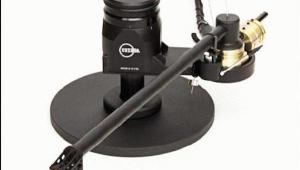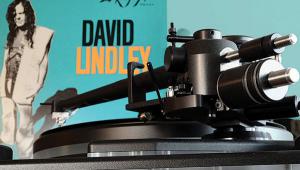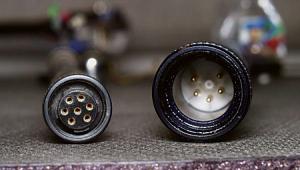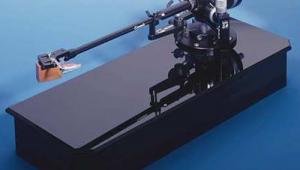HiFiction Thales AV tonearm
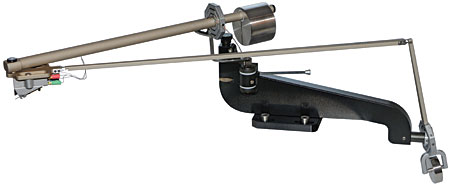
There were also tonearms that were moved in their entirety tangentially across the record surface. One used a multiple-ball bearing trolley reminiscent of what Clearaudio uses today. Some, like those made by Rabco in the 1960s, had bead chains and, later, rubber belts that moved the tonearm assembly via motors activated by microswitches. Goldmund, B&O, and many Japanese companies used tiny, servo-controlled motors to nudge the tonearm along a rail, the motors activated by any loss of the stylus's tangency to the groove, as measured by a photoelectric cell or other light-sensing device.
At the dawn of the CD age, Mitsubishi, Technics, and other Japanese manufacturers, as well as ReVox, also produced so-called "parallel" or "linear" trackers. In 1982, Lou Souther patented a purely mechanical linear tracker in which the cartridge was held by an ultra-low-mass tonearm attached to a low-friction bearing trolley riding on glass rods. Clearaudio bought Souther's patent and further developed the technology in a number of models, including the top-of-the-line Master Reference turntable.
All of these devices were fussy to set up and maintain, and few actually maintained tangency to the groove. Most crabbed their way across the record surface, either because of how the motors were actuated (loss of tangency) or because of "yaw" play inherent in the design.
In addition, there is the issue of the large discrepancy between the tonearm's effective mass in the vertical plane, which is small, and in the horizontal plane mass, which is large, due to the fact that the entire arm assemble is being moved. The resonant frequencies of the arm mass/cartridge suspension compliance in the horizontal and vertical planes are thus very different. Other problems are how to dress the tonearm wires, and how to avoid the friction they cause as the arm travels across the record surface.
But all of these tonearms sure look cool, and some of them sound very good, even if they don't actually maintain the stylus's tangency to the groove. Neither do pivoted arms, of course, yet some of those, too, sound very good.
Air Bearings
In the late 1970s and early '80s, Maplenoll introduced a air-bearing–based arm designed by Bruce Thigpen. In this design, a long rail with an armtube attached to one end slid, virtually without friction, along a cylindrical bearing of pressurized air. (Because the air bearing is housed between two concentric cylinders, it is referred to as a "captured" bearing.) Thigpen marketed an improved version of this design as the Eminent Technology 1 (ET1), and later, with the help of his friend Edison Price, as the much-improved, ergonomically friendlier ET2, which remains popular today (although, to the best of my knowledge, it's no longer in production).
I bought an ET1 as soon as I saw it back in the early 1980s, figuring its frictionless tracking was perfection. At the time I knew nothing about vertical and horizontal resonant frequencies, nor did I consider the system's large horizontal effective mass or the stiffness of the air bearing, or the problems of resonance and turbulence created at the annular gap at either ends of the cylindrical bearing as the highly pressurized air quickly returns to ambient air pressure.
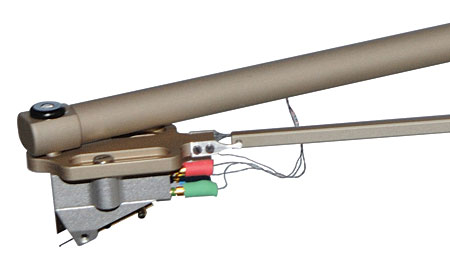
An assortment of other air-bearing tonearms also appeared in the early 1980s from companies such as Airtangent, Forsell, and others. Some were not high-pressure, captured air bearings but low-pressure "hovercrafts" that floated on a cushion of air blown through holes in the top half of the rail. These arms had a great deal of play fore and aft, as well as yaw (ie, these arms pivoted left and right around the bearing's vertical axis). Despite these problems, some of these arms sounded very good. Did they track with true tangentiality? Probably not.
Eventually, I bought a Rockport Technologies 6000 tangential-tracking arm. This featured a sophisticated, low-tolerance, "groove-compensated" air bearing that dealt with the problems of annular gap and bearing slop (see the May 1996 issue, Vol.19 No.5). But I was never happy with the 6000's bass response, and when I reviewed Allen Perkins' original Immedia RPM2 a year later, which was a conventional pivoted arm, I sold the Rockport and bought the Immedia. Whatever tracking error the pivoted RPM2 added was more than made up for by its superior bass performance and its overall speed and solidity (perhaps due in part to its mechanical grounding)—not to mention its ease of use.

